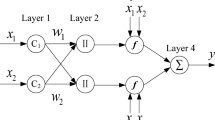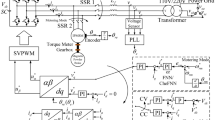Abstract
This paper presents an in-depth study and analysis of the AC drive control simulation of a supercapacitor tram using a high-order neural network pattern discrimination algorithm. Firstly, the line conditions and shunting locomotive operation conditions of a freight coal loading station are analyzed, the capacity of the onboard supercapacitor energy storage device is estimated using traction simulation calculations, the supercapacitor is formed by the series–parallel connection of supercapacitor monoliths group module, and the mathematical model of the supercapacitor energy storage system is obtained. In response to the existence of fuzzy controllers with human-set parameters and potential errors when writing fuzzy rules, the self-learning capability possessed by the adaptive neuro-fuzzy network (ANFIS) is used to improve the accuracy of the prediction model by training and learning to the model a large amount of experimental data with the ANFIS controller, and the simulation model of the dynamic setting of the supercapacitor voltage threshold of the urban rail energy storage system is built using the software, and the comparison and analysis show that the traction network voltage amplitude under the adaptive neuro-fuzzy network control strategy is smaller than the traction network voltage amplitude under the fuzzy control strategy. The global searchability of the optimization algorithm is ensured. In the middle of the search, a medium-precision simplex is used for parallel local search to prevent the searcher from skipping the global optimum in the process of rapid convergence. In the later stage of the search, the optimization range is already within the global optimal range. Subsequently, the advantages and disadvantages of various locomotive topologies are analyzed by using software, and the topology of the supercapacitor shunting locomotive is analyzed according to the design requirements and the actual situation, and the supercapacitor power system scheme of the shunting locomotive is designed, and the traction electric drive system of the supercapacitor shunting locomotive is designed, and its main structural performance parameters are determined. Finally, the overall modeling of supercapacitor shunting locomotive is carried out, including the whole vehicle dynamics model, automatic charging model, supercapacitor model, and motor model, and then, simulation analysis is carried out based on building a relatively perfect model, followed by further stimulation through software to verify the rationality of the design.
Access this article
We’re sorry, something doesn't seem to be working properly.
Please try refreshing the page. If that doesn't work, please contact support so we can address the problem.








Similar content being viewed by others
Explore related subjects
Discover the latest articles, news and stories from top researchers in related subjects.References
Naseri F, Farjah E, Kazemi Z et al (2020) Dynamic stabilization of DC traction systems using a supercapacitor-based active stabilizer with model predictive control. IEEE Trans Transp Electrif 6(1):228–240
Yıldırım D, Akşit MH, Yolaçan C et al (2019) Full-Scale physical simulator of all SiC traction motor drive with onboard supercapacitor ESS for Light-Rail public transportation. IEEE Trans Industr Electron 67(8):6290–6301
Zhang G, Li Q, Chen W et al (2020) Synthetic strategy combining speed self-adjusting operation control and adaptive power allocation for fuel cell hybrid tramway. IEEE Trans Industr Electron 68(2):1454–1465
Zhang G, Li Q, Chen W et al (2019) A coupled power-voltage equilibrium strategy based on droop control for fuel cell/battery/supercapacitor hybrid tramway. Int J Hydrog Energy 44(35):19370–19383
Khodaparastan M, Mohamed AA, Brandauer W (2019) Recuperation of regenerative braking energy in electric rail transit systems. IEEE Trans Intell Transp Syst 20(8):2831–2847
Li H, Zhang X, Peng J et al (2020) Cooperative CC–CV charging of supercapacitors using multicharger systems. IEEE Trans Industr Electron 67(12):10497–10508
Arévalo P, Cano A, Jurado F (2020) Comparative study of two new energy control systems based on PEMFC for a hybrid tramway in Ecuador. Int J Hydrog Energy 45(46):25357–25377
Zhang X, Zhang H, Li H et al (2020) Cooperative charging of supercapacitor trams with current overshoot suppression. IEEE Trans Ind Appl 56(4):4155–4165
Shen Y, Cui P, Wang X et al (2020) Variable structure battery-based fuel cell hybrid power system and its incremental fuzzy logic energy management strategy. Int J Hydrog Energy 45(21):12130–12142
Tseng KC, Chang YC, Cheng CA (2020) Implementation and analysis of ultracapacitor charger in hybrid energy-storage system for electric-vehicle applications. IET Power Electron 13(9):1858–1864
Zhang G, Chen W, Li Q (2017) Modeling, optimization and control of a FC/battery hybrid locomotive based on ADVISOR. Int J Hydrog Energy 42(29):18568–18583
Kasimalla VKR, Velisala V (2018) A review on energy allocation of fuel cell/battery/ultracapacitor for hybrid electric vehicles. Int J Energy Res 42(14):4263–4283
Hames Y, Kaya K, Baltacioglu E et al (2018) Analysis of the control strategies for fuel saving in the hydrogen fuel cell vehicles. Int J Hydrog Energy 43(23):10810–10821
Kaya K, Hames Y (2019) Two new control strategies: For hydrogen fuel saving and extend the life cycle in the hydrogen fuel cell vehicles. Int J Hydrog Energy 44(34):18967–18980
Yan Y, Li Q, Huang W et al (2020) Operation optimization and control method based on optimal energy and hydrogen consumption for the fuel cell/supercapacitor hybrid tram. IEEE Trans Industr Electron 68(2):1342–1352
Veerendra AS, Mohamed MR, Leung PK et al (2021) Hybrid power management for fuel cell/supercapacitor series hybrid electric vehicle. Int J Green Energy 18(2):128–143
Herrera VI, Milo A, Gaztanaga H et al (2018) Design and experimental comparison of energy management strategies for hybrid electric buses based on test-bench simulation. IEEE Trans Ind Appl 55(3):3066–3075
Keskin K, Urazel B (2021) Fuzzy control of dual storage system of an electric drive vehicle considering battery degradation. Int J Optim Control Theor Appl (IJOCTA) 11(1):30–40
Ronanki D, Dasari Y, Williamson SS (2021) Comparative assessment of supercapacitor bank switching techniques under constant resistor, constant current, and constant power loads. IET Electr Power Appl 14(14):2832–2842
Yang Z, Yang Z, Xia H et al (2018) Brake voltage following control of supercapacitor-based energy storage systems in metro considering train operation state. IEEE Trans Industr Electron 65(8):6751–6761
Ou K, Yuan WW, Choi M et al (2018) Optimized power management based on adaptive-PMP algorithm for a stationary PEM fuel cell/battery hybrid system. Int J Hydrog Energy 43(32):15433–15444
Author information
Authors and Affiliations
Corresponding author
Ethics declarations
Conflict of interest
The author declares that there is no conflict of interest in this article.
Additional information
Publisher's Note
Springer Nature remains neutral with regard to jurisdictional claims in published maps and institutional affiliations.
Rights and permissions
About this article
Cite this article
Li, L. Simulation of AC drive control for supercapacitor trams based on high-order neural network pattern discrimination algorithm. Neural Comput & Applic 35, 2243–2255 (2023). https://doi.org/10.1007/s00521-022-07548-z
Received:
Accepted:
Published:
Issue Date:
DOI: https://doi.org/10.1007/s00521-022-07548-z




